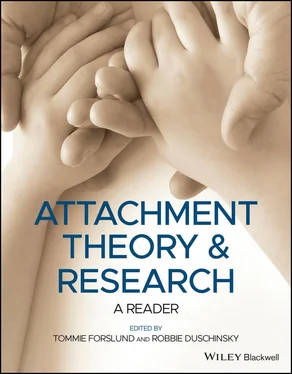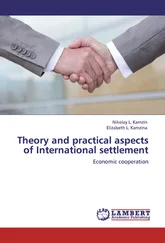It is of course possible to assume that such behaviour always contains an element of foresight – foresight that physiological needs will not be met. Its strength and immediacy, together with what we know about the primacy of clinging, make this, however, seem unlikely. Furthermore, as was stressed in the previous paper, such a theory is unnecessary.
Except for being less mobile, human infants during the second half of their first year seem to respond similarly to the lower primates. By this age they have become much more demanding of their mother’s company. Often when she leaves the room they are upset and do their utmost to see that contact with her is resumed, either by crying or following her as best they can. Such protest behaviour, I am postulating, is accompanied initially only by primary anxiety.
Later, in both humans and chimpanzees, conditioned and expectant anxiety develop as a result of learning. Their development in chimpanzees is of course well attested. Comparing Gua with their son, who was 2½ months older than she, the Kelloggs report: ‘Both subjects displayed what might be called anxious behaviour (i.e. fretting and crying), if obvious preparations were being made by the grown‐ups to leave the house. This led (in Gua) to an early understanding of the mechanism of door closing and a keen and continual observation of the doors in her vicinity. If she happened to be on one side of a doorway, and her friends on the other, the slightest movement of the door toward closing, whether produced by human hands or by the wind, would bring Gua rushing through the narrowing aperture, crying as she came.’ From this account, it seems clear, by a process of learning Gua was able to anticipate and so to avoid the danger of separation.
Similarly with human infants: it is signs that mother is going to leave them that come to evoke conditioned and expectant anxiety most commonly. At what period during the infant’s first year the capacity for foresight develops is difficult to say. Experiment, however, should be easy. If Piaget’s views are confirmed we should expect it to be present from about 9 months.
Not only do attachment behaviour and anxiety responses appear similar in humans and other species, but the same is true of fright responses in the absence of the mother. In such circumstances the young of many species freeze. Robertson noted this in young children soon after starting observations in 1948. Before a child had got to know him and whilst therefore he was still a frightening stranger, a young child in hospital would occasionally respond to his approach by suddenly becoming immobile, as if trying not to be there, though watching him intently the while. In the course of observations made in connexion with his film study, Robertson (1953a) was able to record this response on two occasions when a strange male colleague approached Laura (he himself by this time having become a familiar and reassuring figure). On each occasion Laura reacted by lying down with eyes closed and failed to respond as she usually did to Robertson’s friendly words: indeed only a flicker of the eyelids showed she was not asleep. When told that the man had gone, however, she at once sat up.
Comparable behaviour in infant rhesus monkeys has recently been reported by Harlow and Zimmermann (1954). In the course of their experiments with model mothers they introduced eight baby monkeys for three‐minute periods ‘into the strange environment of a room measuring 6 feet by 6 feet by 6 feet and containing multiple stimuli known to elicit curiosity‐manipulatory responses in baby monkeys. The subjects were placed in this situation twice a week for eight weeks, with no mother surrogate present during alternate sessions and the cloth mother present during the others. … After one or two adaptation sessions, the infants always rushed to the mother surrogate when she was present and clutched her, a response so strong that it can be adequately depicted only by motion pictures. After a few additional sessions, the infants began to use the mother surrogate as a source of security, a base of operations. They would explore and manipulate a stimulus and then return to the mother before adventuring again into the strange new world. The behaviour of these infants was quite different when the mother was absent from the room. Frequently they would freeze in a crouched position.’ Experimental work has also been done with goats and with similar results. 16
If now we return to our account of chimpanzees it is especially to be noticed that, as in the case of Vicki, Gua became strongly attached to a particular figure. In her case it was the male foster‐parent, who in fact did most for her: ‘Her attachment became so strong that she had been in the human environment for fully a month before she would let go of the trouser leg of her protector for any length of time, even though he might sit quietly at a table for as long as an hour. Almost without respite she clung to him in one way or another. If through a temporary lapse in her vigil he should succeed in taking a step or two away from her, it would surely precipitate a frantic scramble after the retreating trousers, to which she would thereafter hang on determinedly.’ Furthermore, it was only when her ‘protector’ was making preparations to leave the room that fretting and crying were exhibited.
These reports draw our attention afresh to the pronounced tendency for instinctual responses to become focused on a particular individual and not merely on a class of individuals. This was emphasized in the previous paper, where I proposed the term monotropy to describe it, and again earlier in this paper when we were discussing how the escape responses of animals tend also to become directed towards a particular object – in this case either a person or a place. Plainly, in the cases of both Vicki and Gua, the crying, clinging, following, and escape responses were fairly narrowly monotropic. Any mother‐figure would not do: it always had to be someone who was known and trusted and, with decided preference, one particular person who was best known and most trusted. As every mother knows, human infants are no different: after a certain age mothering from any kind person will not do.
It seems almost certain in fact that every child who has not been institutionalized develops during his first year a clear preference for one person, namely the person who cares for him and whom I am calling ‘mother’, and this remains the case even though, in addition, he is likely to include a few others to whom he will turn as second best if mother is absent. It is because of this marked tendency to monotropy that we are capable of deep feelings; for to have a deep attachment to a person (or place or thing) is to have taken them as the terminating object of our instinctual responses. It is probably when these responses include those mediating attachment and escape that there exists what Erikson (1950) and others have described as ‘basic trust’.
Unless this high degree of selectivity of the object terminating the response systems mediating attachment and escape behaviour is understood, reactions to separation from loved objects will remain a closed book. This is where, on occasion, formulations stemming from the theory of secondary drive break down. So long as the caretaker ministers efficiently to the child’s physiological needs, it is sometimes reasoned, the child has nothing to grumble about: and so he ought not to grumble. This outlook would be ridiculous were it not so tragic – both for the child and for the well‐intentioned caretaker.
As presented here, separation anxiety is the inescapable corollary of attachment behaviour – the other side of the coin. As soon as the instinctual response systems mediating such behaviour have matured and, by a process of learning of a simple kind, become oriented towards any object whatsoever, the child will become prone to experience primary anxiety at separation from it. Plainly this formulation implies that there is a period early in the infant’s life during which he is not prone to separation anxiety as a specific form of anxiety. This needs discussion.
Читать дальше












